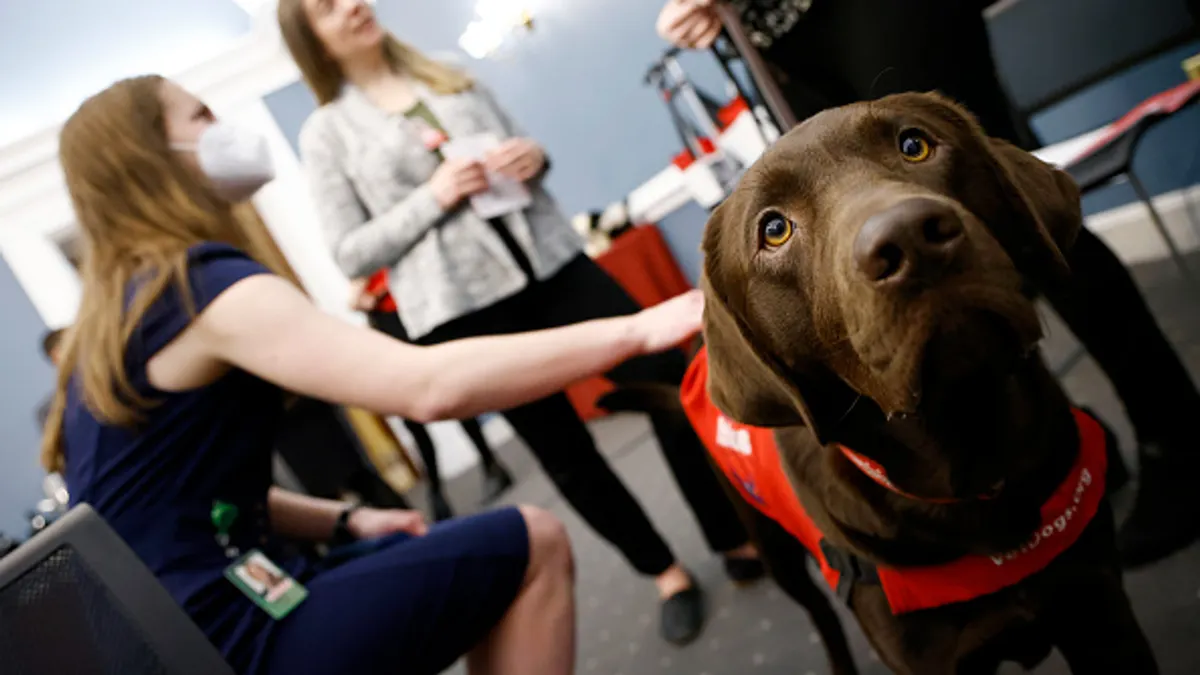Editor's note: Emilie Shumway is an editor for HR Dive. This column is the first in her new series, which will explore how our personal lives intersect with the workplace. She can be reached at [email protected].
A few weeks ago, a rare thing occurred for the HR world — an employment law story went viral.
A jury awarded a Kentucky man $450,000 after his employer, Gravity Diagnostics, failed to stop staff from throwing a birthday party for him in August 2019. According to the complaint, the plaintiff informed his manager of his anxiety disorder five days ahead of time and requested no celebration, as he knew birthday parties triggered his anxiety.
The plaintiff’s manager allegedly forgot to relay the message, resulting in a lunchtime celebration — and the plaintiff experiencing a subsequent panic attack. He spent his lunch break in his car and sent his manager a text, confronting her for failing to accommodate his request, the complaint said.
The next day, the employee was summoned for a meeting with two managers, who “confronted and criticized” him about his reaction to the event, which triggered another panic attack, the complaint said. The plaintiff was sent home for the remainder of that day and the next day. A few days later, a Sunday, the company terminated him via email “because of the events of the previous week.”
He sued, alleging disability discrimination and retaliation.
As in many such cases, the details paint a more complicated picture than many news stories. In its motion for summary judgment, for example, the company claimed that the plaintiff never disclosed his condition. Company managers also said they were alarmed by the behavior prompted by his panic attack, which included the plaintiff becoming red-faced, closing his eyes and clenching his fists.
Ultimately, the plaintiff won the suit, and Gravity Diagnostics learned a $450,000 lesson.
Recognize anxiety
Like many others, this case intrigued me. I’m one of nearly 7 million American adults with generalized anxiety disorder, and one of those for whom the condition has interrupted work. This happened most notably about 10 years ago, when I was 24, new to a full-time office job and trying to manage a variety of personal and financial stresses.
For those who haven’t experienced it, I think anxiety can seem highly conceptual and approachable as a mental illness. It may sound like distraction and worry, a little mental storm that saps productivity.
While distracting thoughts are certainly part of it, the real pièce de résistance of an anxiety disorder is the mind-body feedback loop. Worried thoughts lead to worried beliefs, which lead the heart to race, the face to redden and the body to break out in sweat. After the body grows accustomed to producing intense physical responses, they can happen seemingly at random — based simply on a premonition that something bad will happen.
I thought I was having a heart attack.

Cara Pelletier
Senior director of DEI, 15Five
I have multiple times verged on a panic attack while grocery shopping or out with friends. The plaintiff in the Gravity Diagnostics case knew birthday parties to be a trigger based on past events associated with his birthday, according to the company’s motion for summary judgment.
For Cara Pelletier, senior director of DEI at performance management platform 15Five, the story of the birthday party lawsuit struck a chord.
“I'm somebody who has had a panic attack at work,” she told me. “I was sitting at my desk on a Monday morning here at home, doing my work, and all of a sudden I thought I was having a heart attack. It felt like my brain was in one place and my body was sprinting away from me as fast as it could.”
“When I hear about that employee having a panic attack at the office, I can't even imagine. I mean, I was working alone in my home office — I wasn't on Zoom — and I was mortified at what was happening to me,” Pelletier said. “I can't imagine what it would have been like to be the center of attention at an event and have that panic attack occur because, you know, I was not able to think my way out of it.”
My own anxiety once resulted in me dissociating during a meeting, excusing myself to call my mother and disclosing that I was pretty sure I had “intracranial pressure,” a condition I had Googled my way into awareness of just hours before. With anxiety, there’s knowing you’re being irrational — and then there’s your body telling you to follow your intuition of doom.
Address anxiety at work
HR pros can promote employee wellness in a few ways. First, they should understand that mental illnesses like anxiety and depression are, in fact, disabilities. The Americans with Disabilities Act defines a disability as a “physical or mental impairment that substantially limits one or more major life activities.” Recurring panic attacks and distracting symptoms can present substantial limitations.
“Despite the Americans with Disabilities Act having been law for over 30 years in this country, businesses, and in particular managers, still have a long way to go to really understand what it means and how to best support people with disabilities in their businesses,” Pelletier said. “The vast majority of disabilities are nonapparent, meaning you're not going to know somebody has one unless they tell you.”
There are a slew of reasons employees dealing with anxiety may be hesitant about disclosing that fact, from concerns about it affecting their career prospects to the stigma surrounding disabilities related to mental conditions to a lack of awareness that their experience even qualifies as a disability (and therefore may require accommodation).
“About 20% of people in America are experiencing mental illness currently, and over half of those people will never get treatment,” Pelletier said. “They're afraid of how they're going to be perceived if they do ask for help — if they're going to be perceived as less competent, or, you know, ‘crazy’ or mentally unstable at work, as opposed to [the employer] recognizing that this is a very common thing.”
Employees should certainly not be hounded into disclosing disabilities, but employers can create an environment in which they know it’s safe to do so. Pelletier, who holds a leadership position at 15Five, told me she is “very public and open as being somebody who is disabled. Not only do I have a hearing aid, but I'm also dual-diagnosed with ADHD and autism.”
Leaders also can destigmatize disabilities like anxiety by increasing their attention on mental health — a route many companies have taken in the last year, as the pandemic, caregiving and remote work have all taken a toll on employees.
How a company handles communications related to mental health can make a big difference, too. “One of the ways that employers can help people pay attention to [a mental health session] is if that session is sponsored by or introduced by a C-level executive — if your CEO sends out an email to people that says, ‘Hey, May is Mental Health Awareness Month … protecting and supporting your own mental health is really important to me, and here's why. Come learn about our benefits,’” Pelletier said.
“I think if it just comes from HR — if it just comes from the benefits team — it's really easy for people to drown it out,” Pelletier added. “But if it comes from an executive, it can grab people's attention in a different way.”
Benefits that actually help
Many companies provide some form of mental health benefits, with a common version being access to an employee assistance program and a set number of free counseling sessions.
Among employee respondents to a November survey that said they declined to use their employer’s mental health resources, a quarter said they did so because they “didn’t know how to access it, because they were concerned about confidentiality, or because they were concerned about cost.”
Providing strict limitations on coverage — three free sessions, for example — can seem laughably paltry when one is in an anxiety spiral. One of the most effective forms of counseling for anxiety and depression, cognitive behavioral therapy, can take three to five months of weekly sessions.
Recently, some employers have experimented with other methods to help employees address their mental health. This year, HR tech company Phenom offered its employees up to $1,000 in mental health reimbursement support. Given that the average therapy appointment can cost $100 to $200, the benefit could allow an employee to choose their therapist and potentially afford 5 to 10 sessions before having to pay. (It does not appear from the announcement that employees would be required to use the funding for therapy.)
Some employers have invested in longer access to sessions. Starbucks offers employees up to 20 free counseling sessions through its EAP, and PwC recently announced 12 free sessions, plus 90% reimbursement on out-of-network mental health support. 15Five, where Pelletier works, offers employees and their immediate families unlimited use of the online counseling platform BetterHelp, she said.
Just as important as access to therapy services, however, is scheduling flexibility to use them. Employers can communicate that if an employee needs to leave for an hour or two per week for a therapy appointment, the workplace can provide the flexibility for them to make up that time. Many employers allow workers to get a physical, go to a prenatal appointment or visit the dentist. Why should mental healthcare be any different?
While it’s always a good time to let employees know their mental health matters, May is Mental Health Awareness Month, Pelletier pointed out. It’s an excellent time to explore more robust mental health benefits and to remind employees — or better yet, have the CEO remind employees — of the resources available to them.






















